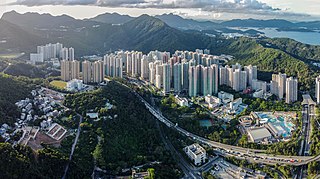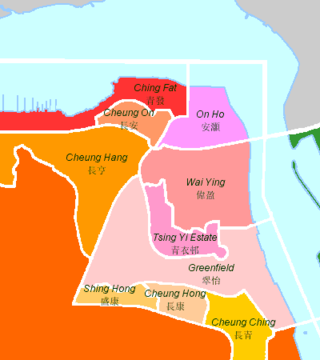
The Hong Kong Housing Authority (HA) is the main provider of public housing in Hong Kong. It was established in April 1973 under the Housing Ordinance and is an agency of the Government of Hong Kong. In the same year, the Resettlement Department and the Building Section of the Urban Services Department were merged to form the Housing Department, which acts as the Housing Authority's executive body.

Po Lam is a neighbourhood in northern Tseung Kwan O, Kowloon. An MTR station with the same name, Tseung Kwan O Village, Yau Yue Wan Village, King Lam Estate, and Po Lam Estate are located there.

The following is an overview of public housing estates on Tsing Yi, Hong Kong including Home Ownership Scheme (HOS), Private Sector Participation Scheme (PSPS), Flat-for-Sale Scheme (FFSS), Tenant Purchase Scheme (TPS) and Subsidised Sale Flats Project (SSFP) estates.

The following is a list of public housing estates in Yuen Long New Town, Hong Kong, including Home Ownership Scheme (HOS), Private Sector Participation Scheme (PSPS), Sandwich Class Housing Scheme (SCHS), Flat-for-Sale Scheme (FFSS), and Tenants Purchase Scheme (TPS) estates.
The following is an overview of public housing estates in Yau Tong, Kwun Tong, Kowloon, Hong Kong, including Home Ownership Scheme (HOS), Private Sector Participation Scheme (PSPS), and Tenants Purchase Scheme (TPS) estates.

The following is an overview of public housing estates in Quarry Hill and No. 12 Hill, Kowloon, Hong Kong, including Home Ownership Scheme (HOS), Private Sector Participation Scheme (PSPS), Sandwich Class Housing Scheme (SCHS), Flat-for-Sale Scheme (FFSS), and Tenants Purchase Scheme (TPS) estates.
The following shows the public housing estates, including Home Ownership Scheme (HOS), Private Sector Participation Scheme (PSPS), Tenant Purchase Scheme (TPS) in Lam Tin of Kwun Tong District, Kowloon, Hong Kong.

Tak Tin Estate is a mixed public/TPS estate in Lam Tin, Kowloon, Hong Kong. It consists of 9 blocks completed in 1991 and 2001. In 1999, some of the flats were sold to tenants through Tenants Purchase Scheme Phase 2.

The following is an overview of Public housing estates in Cheung Sha Wan, Hong Kong, including Home Ownership Scheme (HOS), Green Form Subsidised Home Ownership Scheme (GFSHOS), Private Sector Participation Scheme (PSPS), and Tenants Purchase Scheme (TPS) estates.

The following is an overview of public housing estates in Sham Shui Po, Hong Kong, including Home Ownership Scheme (HOS), Private Sector Participation Scheme (PSPS), and Tenants Purchase Scheme (TPS) estates.
The following shows the public housing estates in Ngau Tau Kok, Jordan Valley, Kowloon Bay and surrounding neighbourhoods, in Kwun Tong District, Kowloon, Hong Kong.

The following is a list of public housing estates in Wong Tai Sin, Kowloon, Hong Kong including Home Ownership Scheme (HOS), Private Sector Participation Scheme (PSPS), Sandwich Class Housing Scheme (SCHS), Flat-for-Sale Scheme (FFSS), and Tenants Purchase Scheme (TPS) estates.
The following shows the Resettlement Housing estates in Tsz Wan Shan, Wong Tai Sin District, Kowloon, Hong Kong.

Tsz Ching Estate is a public housing estate located in Tsz Wan Shan, Kowloon, Hong Kong next to Tsz Oi Court. It consists of eleven residential blocks completed between 1993 and 2001. The site was formerly Blocks 48 to 53 in Tsz Wan Shan Estate, which was also called "Tsz Ching Estate". After redevelopment, the eastern part of Old Tsz Oi Estate was assigned to Tsz Ching Estate.

The Kai Tak Development, abbreviated as "KTD" and formerly called South East Kowloon Development (東南九龍發展計劃), refers to the redevelopment of the former Kai Tak Airport site in Kai Tak, Kowloon, Hong Kong.

Kai Ching Estate is a public housing estate in a brownfield development area of the disused Kai Tak Airport in Hong Kong. It consists of six residential buildings completed in 2013. It houses around 5,200 flats for 13,300 residents and shares the "Ching Long Shopping Centre" with Tak Long Estate. Kai Ching Estate was built by China State Construction Engineering.

Samples of potable water in Hong Kong were found to contain excessive levels of heavy metals including lead, nickel and cadmium in 2015. Such discoveries of contamination caused widespread crisis within the city.

King Tai Court is the first Green Form Subsidised Home Ownership Scheme court developed by the Hong Kong Housing Authority and located at King Fuk Street, San Po Kong of Wong Tai Sin District, Kowloon, Hong Kong. It commenced in June 2017.

Kai Long Court is a Home Ownership Scheme (HOS) court developed by the Hong Kong Housing Authority and located at 18 Muk On Street, Kai Tak Development of Kowloon City District, Kowloon, Hong Kong. It commenced in March 2019.

Long Ching Estate is a public housing estate in Yuen Long, New Territories, Hong Kong, near Tai Kiu Tsuen and within walking distance to MTR Long Ping station. It consists of two residential blocks completed in 2016.




























